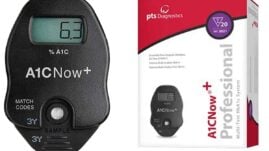A glycated hemoglobin A1c test (HbA1c) measures your average blood glucose levels over the past 2 to 3 months.
But what constitutes a dangerous level of A1c? In this article, we will explore the A1c levels that are considered too low or too high, and discuss strategies to improve your levels if they are deemed dangerous.

Key facts
- Normal A1c levels are below 5.7 percent, prediabetes is between 5.7 percent and 6.4 percent, and diabetes is diagnosed at 6.5 percent or higher.
- The American Diabetes Association recommends maintaining an A1c below 7 percent for adults to prevent diabetes complications.
- An A1c lower than 5 percent may indicate frequent low blood glucose (sugar), which can be dangerous, especially for those with hypoglycemia unawareness or who live alone.
- Levels above 9 percent significantly increase the risk of serious health issues such as heart disease, stroke, retinopathy (eye damage), and kidney failure.
- Effective management includes adjusting medications, diet, and exercise, using tools like CGMs and insulin pumps, and consulting healthcare professionals to maintain a safe A1c level.
What are the different A1c levels?
The American Diabetes Association categorizes A1c levels to help identify diabetes management status:
- Normal (No Diabetes): A1c below 5.7 percent
- Prediabetes: A1c between 5.7 percent and 6.4 percent
- Diabetes: A1c of 6.5 percent or higher
Individual A1c goals can vary depending on personal health circumstances. For instance, a higher A1c may be recommended for people who live alone or have difficulty detecting low blood sugars (a condition known as hypoglycemia unawareness).
The ADA recommends that adults maintain an A1c below 7 percent to prevent complications associated with diabetes, while children should aim for an A1c below 7.5 percent.
What is a dangerous A1c level?
Managing A1c levels is important, as both high and low levels carry significant health risks. It’s essential to work with your doctor to determine your ideal A1c target, which will vary based on your lifestyle, health goals, and life stage.
An A1c lower than 5 percent
An A1c lower than 5 percent in people with diabetes is uncommon and, while commendable, levels under 5 percent could indicate frequent hypoglycemia.
This situation becomes particularly concerning if you are older, live alone, or have difficulty detecting when your blood sugar levels are low.
In these scenarios, the consequences of hypoglycemia can be more dangerous, potentially leading to severe outcomes such as diabetic coma or death.
If you often experience low blood sugars, it is crucial to discuss the possibility of adjusting your insulin doses with your doctor to maintain your A1c at a safer level without frequent lows.
It’s important to note that people newly diagnosed with type 1 diabetes may temporarily exhibit very low A1c levels during what is known as the “honeymoon phase.” This period occurs when the pancreas still produces some insulin.
An A1c higher than 7 percent
The ADA recommends that most adults aim to keep their A1c below 7 percent to prevent diabetes-related complications. For children, the goal is typically set below 7 to 7.5 percent, depending on the individual situation, reflecting the need to balance blood sugar management with the risk of hypoglycemia.
However, managing diabetes effectively can be challenging due to various life factors. While an A1c between 7 percent and 8 percent exceeds the ideal target, it may not immediately lead to complications.
Nonetheless, it is important to aim for lower levels to reduce the long-term risk of diabetes-related health issues.
An A1c higher than 9 percent
Levels higher than 9 percent significantly increase the risk of severe diabetes complications, such as heart disease, nerve damage, and kidney failure. The risk continues to escalate with each percentage increase in A1c.
Ways to make your A1c safer
Adjusting your A1c, whether increasing or decreasing it, is crucial if you’re nearing dangerous levels. Here’s how you can safely manage your A1c:
If your A1c is too low:
- Speak with your healthcare provider: Discuss the possibility of reducing your medications or insulin dosages to avoid frequent lows.
- Moderate your exercise: If physical activity leads to hypoglycemia, consider reducing the intensity or duration of your workouts.
- Adjust your diet: Increase your intake of proteins and fats, which can help stabilize blood sugar levels, particularly overnight.
- Use a continuous glucose monitor (CGM): A CGM can help you detect low blood sugars before they become critical, allowing for timely intervention.
- Optimize insulin pump settings: If you use an insulin pump, adjust your basal insulin rates temporarily for activities that lower blood glucose, like exercise, to prevent hypoglycemia.
These strategies can help maintain your blood glucose at a safe level, minimizing the risk of both high and low extremes.
If your A1c is too high
- Speak with your doctor: Work with your healthcare provider to adjust your medications or insulin dosages to better manage your blood sugar levels.
- Increase physical activity: Incorporate more physical activity into your daily routine to help lower blood glucose levels.
- Eat a balanced diet: Focus on lower-carbohydrate meals and include plenty of whole foods rich in fiber. Avoid processed foods and items with added sugars.
- Track carbohydrates: If you find counting carbohydrates challenging, keep a food journal and seek guidance from a registered dietitian nutritionist (RD/RDN) for meal planning.
- Monitor blood sugar: Check your blood sugar multiple times a day or use a CGM to detect high blood sugars early.
- Optimize insulin pump settings: If you use an insulin pump, adjust the basal rates throughout the day and night to prevent prolonged high blood sugars.
- Prioritize sleep: Aim for 7 to 9 hours of sleep per night to improve insulin sensitivity.
- Manage stress: Practice stress-reducing activities like yoga, meditation, and deep breathing exercises to decrease insulin resistance.
Home A1c testing
A1c test kits are available for home use and can be purchased at local pharmacies or online, allowing for convenient monitoring.
For more in-depth information on how to lower your A1c, watch this video by Christel Oerum, founder of Diabetes Strong. In the video, she explains how she successfully lowered her A1c to 5.7 percent in 30 days by following five simple steps:




